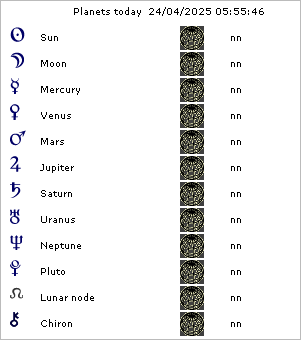|
|
Longitude and latitude in choosing an RSR – Signs of short and long ascension
To go into a little more detail from a "technical" point of view in the fascinating world of RSR it is indispensible to know few but essential concepts that do not exclusively concern astrology but that allow us to understand the subject of Relocated Solar Returns(RSR) more easily.
These concepts regard geography and cartography and in this section dedicated to Active Astrology you will find articles in two separate "parts": the one that you are currently reading and another one called: "A few simple geographical concepts to find your way in an RSR” that you will see on the next page.
In this Astrology online section, we take for granted that whoever has reached this point knows, for example, that astrology is based on a an anthropocentric point of view (being a person who is ideally located at the centre of the universe along with the Earth) in antithesis with the pre-Galilean understanding that established what is now generally understood by everyone, in other words that in our universe it is the Sun which is at the centre of everything and all the other planets rotate around it (including the Earth).
Another basic concept is about the definition of the Ascendant, which in a horoscope is the degree of the zodiac sign that rises in the East on the horizon at the moment of the birth in question.
Our observation point for all births in fact depends on terrestrial co-ordinates, which are the following: longitude and latitude of the place of birth, which are measured in degrees, first minutes and second minutes.
Latitude:
These are lines that form parallel circles in respect of the equator that has 0° latitude (just to ensure you understand: the horizontal circles that you see on globes). Each of these circles measures a degree and in all there are 90 of them North and 90 South of the equator. This means that two cities that are very far away from each other may have very little difference in terms of latitude which, remember, defines the position of a place in a North-South direction: for example, Buenos Aires is at 34° and 40’ south of the equator and Sydney is at 33° and 32’ south of the equator.
To conclude: latitude=parallels
Longitude:
These are perpendicular vertical lines to the polar axis all passing through the equator. They are called meridians and there are 24 fundamental meridians which scan the changing of the hours and therefore at the same time define a longitude and a time zone (which greatly interests us regarding RSR!).
Longitude defines the position of a place in an East - West direction compared to the meridian of Greenwich (the reference point to calculate the Ascendant for births all over the planet) that conventionally measures 0 degrees which is why the two aforementioned cities in terms of latitude, which have latitudes that are very close instead have very different longitudes: Buenos Aires is at 58° and 30’ West of Greenwich and Sidney is to 151° and 10' to the East of Greenwich.
To conclude longitude=meridians.
Regarding longitude Ciro Discepolo recommends using hours and not degrees as the reference point. For example: if you are told that Buenos Aires is 58° and 30' West of Greenwich it will be easier to understand that it is four hours behind compared to Greenwich, which will help you to more quickly "target" the location to choose for your birthday. Further on we will explain why.
Time zones:
The movement of the Earth occurs from the West towards the East and in this direction there are 23 time zones which, as we were saying earlier, are fundamental for the choice of location to be "aimed" for an astrological birthday, and it determines the real element for choosing a specific location rather than another. The time zone is a space on the surface of the Earth between two Meridians at a distance of 15°. The Earth’s surface has been divided into 24 parts to give all countries a conventional time. Each time zone uses the time of its Central Meridian that is an hour later than that of the meridian immediately to the West. Each time zone corresponds to an hour of time. For example, New York compared to Italy is 5 hours and 56 minutes behind, while compared to Greenwich it is only 5 hours behind: this is because Italy is east of Greenwich, which measures 56 more minutes compared to the 0° Greenwich meridian. This is why New York is 5 hours and 56 minutes behind compared to the time we have in Italy.
Also considering the subject of time zones, the founder of Active astrology, Ciro Discepolo, has summarised a very useful rule that we describe below: "In order to calculate the hour of the RSR, do not take into account any summertime official time and add or subtract the time zone difference between London and the destination, if an official time is not used in this area. If, alternatively, both locations use official time, calculate the time zone difference and then you add an hour”.
Ecliptic:
This is the apparent circular trajectory caused by the movement of the Sun around the Earth (about one degree per day). In fact a year is composed of 365 days, the zodiac measures 360°, and each zodiac signs measures 30° (in fact it lasts about thirty days) and each day is equivalent to about one degree.
Ok?
Behind this apparent trajectory of the Sun - but compared to our observation point it remains on the same level - there is the movement of the 12 signs of our zodiac which in all measure 17° in latitude (8.5° north and 8.5° South of the ecliptic) and 360° in longitude; instead, the ecliptic, which nevertheless also measures 360° in longitude, is tilted compared to the equator by 23° and 27’. The ecliptic crosses the equator (celestial) in two points: at 0° Aries and 0° Libra, in other words during the spring and autumn equinoxes when the light of day has the same duration as night-time light.
The stars of our solar system, according to an astrological point of view that is anthropocentric, therefore move in the space between 360° in latitude and 17° in longitude.
The latter issue, which seems a little complicated (well, not that much surely!) is essential for understanding the concept of signs of short and long ascension that we will discuss next.
Signs of short and long ascension:
A sign is defined as being one with a short ascension (for simplicity it is a sign “that doesn’t last long”) that rises in the East of the horizon way before a sign of long ascension (a sign “that lasts a long time”). For example observing the table of houses over Rome, we discover that there are certain zodiac signs that ascend (or rather rise up) way before others:
Aries: 1h. 10'
Taurus: 1h. 20'
Gemini: 1h. 51'
Cancer: 2h. 22'
Leo: 2h. 30'
Virgo: 2h. 34'
Libra: 2h. 37'
Scorpio:2h. 29'
Sagittarius:2h. 21'
Capricorn:1h. 50'
Aquarius:1h. 24'
Pisces: 1h. 10'
So, you can see that Aries compared to Libra has as much as 1h. and 27' less! So what? Hold on a second … to calculate the Ascendant in a horoscope the obliqueness of the zodiac counts (under the element “Ecliptic“ we have said that the zodiac begins at 0° Aries to reach a maximum tilting at 23° and 27' of Cancer), and therefore according to an increase or decrease in the tilting of the signs they move with different speeds and so some of them rise earlier than others.
It is important to know this to quickly understand that if, for example, an Ascendant of an SR in Taurus falls on Milan (a sign of short ascension) in the first radical house (a very bad position – which we discovered thanks to the studies undertaken by Ciro Discepolo – later we will explain why it is so bad) and you would like to move that Ascendant into your 2 ^ radical house, all you probably have to do is to move towards Athens (therefore East of Milan) to put the Ascendant in the 2 ^ Radical House and you’ve finished. So take note: if you move East of Milan the Ascendant of Taurus "descends" in the following sign and as a result in the following house. If instead the Ascendant of the SR always falls in the first radical house in Virgo (a sign of long ascension) well then it’s not sufficient to go to Athens to place it in the 2 ^ or the 3 ^ house, but you should go “further along” to the East (to gain time zones) such as Istanbul, and so on. A great deal of the RSR "technique" is based on attempts to move to the East or to the West of where you are to "lower" or to "raise" the SR Ascendant according to your needs, but we’ll be discussing this in the article dedicated to the geography.
Print this article
|
 |
|



